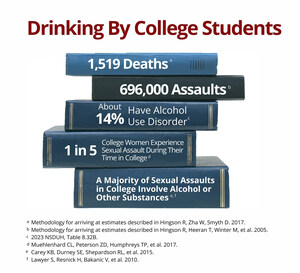NIAAA: Fall Semester--A Time for Parents To Discuss the Risks of College Drinking
News provided by
National Institute on Alcohol Abuse and Alcoholism, National Institutes of HealthAug 15, 2024, 09:15 ET
BETHESDA, Md., Aug. 6, 2024 /PRNewswire/ -- As college students arrive on campus this fall, it is typically a time of new experiences, new friendships, and making memories that will last a lifetime. Unfortunately for many, the National Institute on Alcohol Abuse and Alcoholism (NIAAA) says, it is also a time of harmful and underage drinking and of dealing with its aftermath—from vandalism, sexual assault, and other forms of violence to injuries and death.
Rates and Consequences of College Drinking
According to the 2023 National Survey on Drug Use and Health (NSDUH), 45.3% of male and 48.5% of female full-time college students ages 18 to 22 drank alcohol in the past month. About 29.3% of male and 28.0% of female full-time college students engaged in binge drinking during the same time frame. The Substance Abuse and Mental Health Services Administration (SAMHSA) defines binge drinking as five or more drinks on an occasion for men and four or more drinks on an occasion for women. (NIAAA defines binge drinking as a pattern of drinking alcohol that brings blood alcohol concentration [BAC] to 0.08%—or 0.08 grams of alcohol per deciliter—or more. This typically happens if a woman has four or more drinks or a man has five or more drinks within about 2 hours.) In addition, 6.0% of male and 6.7% of female full-time college students engaged in heavy alcohol use, defined by SAMHSA as binge drinking on 5 or more days in the past month.
The consequences of harmful and underage drinking by college students are more significant, more destructive, and more costly than many parents realize. And these consequences affect students whether they drink or not. Researchers estimate that each year:
- Deaths: 1,519 college students between the ages of 18 and 24 die from alcohol-related unintentional injuries, including motor vehicle crashes.
- Assaults: 696,000 students between the ages of 18 and 24 are assaulted by another student who has been drinking.
- Sexual assaults: Although estimating the number of alcohol-related sexual assaults is exceptionally challenging—since sexual assault is typically underreported—researchers have confirmed a long-standing finding that 1 in 5 college women experience sexual assault during their time in college. A majority of sexual assaults in college involve alcohol or other substances. Research continues in order to better understand the relationships between alcohol and sexual assault among college students. Additional national survey data are needed to better estimate the number of alcohol-related assaults.
- Alcohol use disorder (AUD): Roughly 14% of college students meet the criteria for AUD.
- Academic consequences: About 1 in 4 college students report academic consequences from drinking, including missing class, falling behind in class, doing poorly on exams or papers, and receiving lower grades overall.
Early Weeks Are Critical
Although some students come to college already having some experience with alcohol, certain aspects of college life, such as unstructured time, the widespread availability of alcohol, inconsistent enforcement of underage drinking laws, and limited interactions with parents and other adults, can intensify the problem.
The first 6 weeks of freshman year are a vulnerable time for harmful and underage college drinking as well as for alcohol-related consequences because of student expectations and social pressures at the start of the academic year.
Parents Can Help
An often overlooked protective factor involves the continuing influence of parents during the college years. Research shows that students who abstain from drinking often do so because their parents discussed alcohol use and its adverse consequences with them. During these crucial early weeks, parents can do a number of things to stay involved.
Parents can help by:
- Talking with students about the dangers of harmful and underage college drinking—such as the possible legal and school penalties for underage drinking and the risks of alcohol overdose, unintentional injuries, violence, unsafe sexual behavior, academic failure, and other adverse consequences
- Reaching out periodically and keeping the lines of communication open while staying alert for possible alcohol-related problems
- Reminding students to feel free to reach out to them to share information about their daily activities and to ask for help if needed
- Learning about the school's alcohol prevention and emergency intervention efforts (see "Resources Are Available" section)
- Making sure students know the signs of alcohol overdose or an alcohol-related problem, and how to help
Resources Are Available
For parents who want to discuss the consequences of drinking with their college students, a variety of helpful resources are available from the NIAAA College Drinking Prevention website.
These resources include a parents' guide that offers research-based information plus helpful advice on choosing the right college, staying involved during freshman year, and getting assistance if faced with an alcohol-related crisis. The website also provides links to alcohol policies at colleges across the country, an interactive diagram of how alcohol affects the human body, and an interactive alcohol cost calculator.
Additionally, NIAAA's booklet and website CollegeAIM—the College Alcohol Intervention Matrix helps schools and parents address harmful and underage student drinking by identifying effective alcohol interventions.
For more information, please visit: CollegeDrinkingPrevention.gov.
SOURCE National Institute on Alcohol Abuse and Alcoholism, National Institutes of Health

WANT YOUR COMPANY'S NEWS FEATURED ON PRNEWSWIRE.COM?
Newsrooms &
Influencers
Digital Media
Outlets
Journalists
Opted In




Share this article